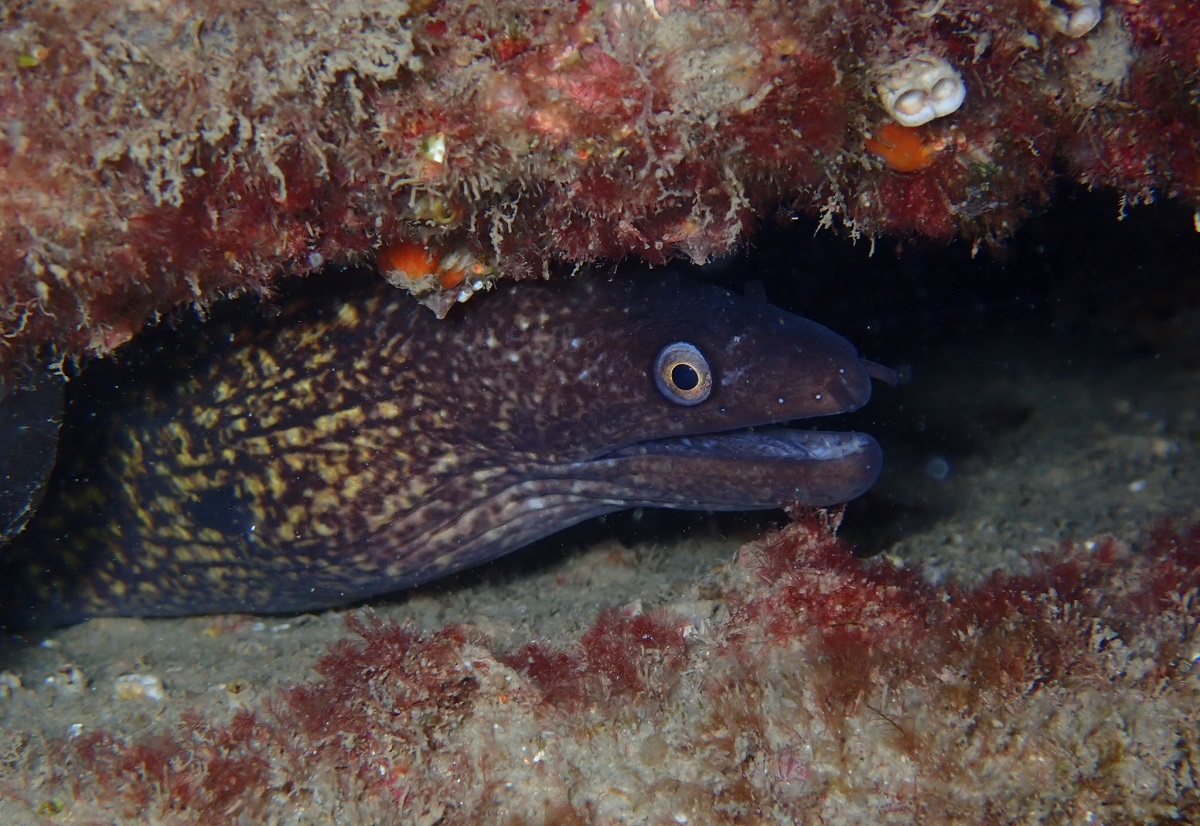Went snorkeling in the Mediterranean and spotted a moray eel head sticking out from under a rock? Congrats, you likely just met Muraena helena, better known as the Mediterranean moray! Don’t worry: although this fish has big teeth, it’ll leave you alone as long as you don’t bother it.
Below, let’s have a look at everything there is to know about the Mediterranean moray eel, its natural habitat, diet and more!
| Name (common, scientific) | Mediterranean moray eel, Roman eel, black moray, Muraena helena |
| Family | Muraenidae |
| Spread | Mediterranean Sea, Eastern Atlantic Ocean |
| Habitat | Rocky bottoms and crevices |
Mediterranean moray eel appearance
The Mediterranean moray eel is undoubtedly one of the more scary-looking species you can come across while snorkeling in the Mediterranean. Like other moray eels, it has an elongated, snake-like body. It can grow to up to almost 1.5m (5ft) in length and weigh a whopping 15 kg (35 pounds).
Mediterranean morays are a greyish dark brown in color, with a pattern of golden spots all over the body and especially on the underside. They have yellowish-brown eyes.
Like other moray eels, Muraena helena has a large mouth full of needle-like teeth, perfect for grabbing hold of wriggling fish and tough crabs.
Did you know? Unlike many other fish species, moray eels don’t have scales. Instead, their smooth skin is protected by a slimy (and toxic!) mucus layer.
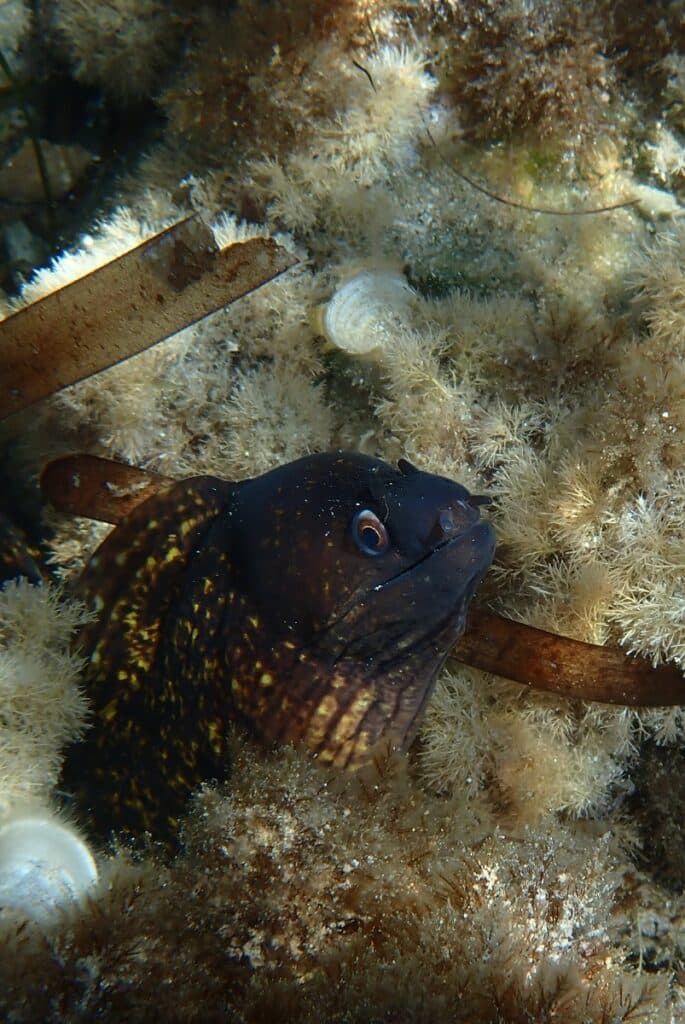
Mediterranean moray eel natural habitat
Range
Despite its name, the Mediterranean moray eel isn’t only found in the Mediterranean Sea, although there are indeed plenty of them in those parts. It also occurs in the eastern Atlantic, particularly around Macaronesia (Canary Islands, Azores, Cape Verde).
Muraena helena has also been spotted further up north, like in Ireland, England, France, and Belgium. It’s not very frequently seen in these colder waters, though.
The IUCN Red List last assessed the Mediterranean moray eel in 2011. It considers Muraena helena to be a species of Least Concern, noting it to be common in parts of its range.
Did you know? Muraena helena is visually similar to another species in the genus, Muraena augusti. In fact, since they both occur in the eastern Atlantic, they were considered to be the same species for a while. M. augusti was resurrected as a species following a 2007 study that concluded the two are, in fact, not the same.
Habitat
In terms of habitat, this is a typical moray eel. Members of the moray family Muraenidae are bottom dwellers that spend most of their time in natural and man-made crevices and caves. They can be quite territorial about their favorite holes.
The Mediterranean moray prefers rocky zones at depths between 15-300m (50-1000 ft), although I’ve seen them in shallower areas as well. I once came across one at barely 1m (3.2 ft) while snorkeling! The species is also occasionally spotted way deeper, all the way down to 800m (2600+ ft).
Male and female Mediterranean moray eels appear to have different depth preferences. The females are more common in the shallows, while the males like deeper waters. When time comes to reproduce, both move to the deep sea.
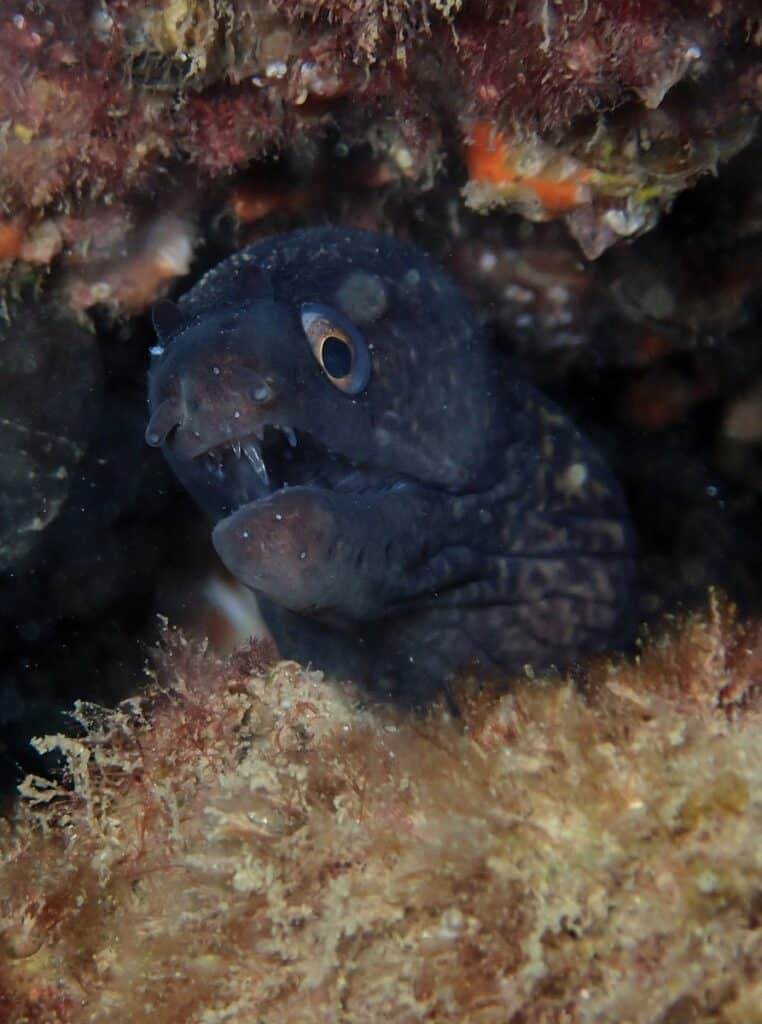
Mediterranean moray eel diet
The Mediterranean moray eel is one of the apex predators in its natural habitat. As mentioned earlier, these opportunistic carnivores use their super-sharp chompers to catch pretty much anything that strays too close to their lairs, from fish to invertebrates and all sorts of crustaceans.
A 2013 study found that Muraena helena specimens had a wide range of species in their stomachs. Benthic (bottom-dwelling) fish and crustaceans like crabs and prawns were most commonly found. Octopi were popular as well, especially in eels that occurred in deeper waters.
Dentists
Yep, moray eels have dentists. Those many teeth don’t maintain themselves! Plenty of bits get stuck in there after meals, but luckily, a few fish and invertebrate species are brave enough to crawl right into the Mediterranean moray’s mouth to pick them clean.
Most notable is Lysmata seticaudata, a small striped species of shrimp also known as the Monaco shrimp. It doesn’t end there, though. A 2019 study found that two fish species (Lepadogaster candolii or the Connemara clingfish and Parablennius rouxi or the longstriped blenny) also acted as moray eel dentists.
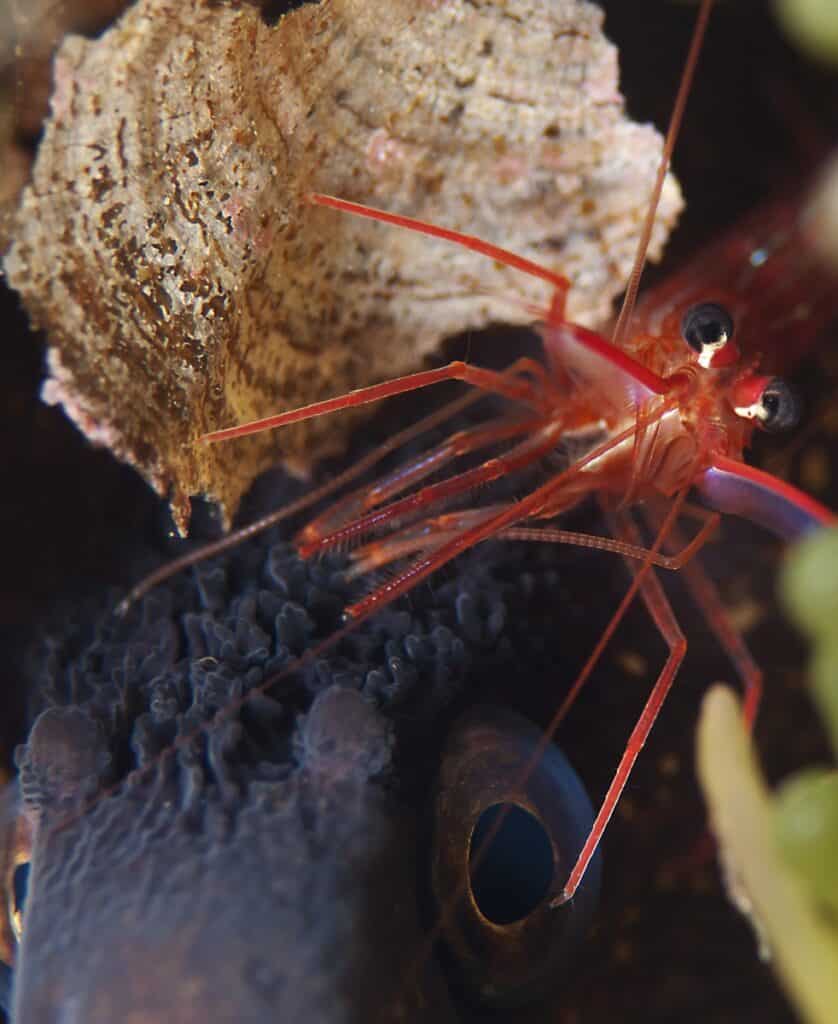
Mediterranean moray eel facts
Bite
Unsurprisingly given those formidable teeth, the Mediterranean moray eel can be dangerous to humans. They will bite if provoked, like if you disturb one in its lair. Their bite isn’t explicitly toxic, but it’s nasty and the wound can easily get infected without the right medical care.
Luckily, Mediterranean morays aren’t the most aggressive of eels—that questionable honor goes to the green moray eel (Gymnothorax funebris), in my personal opinion. They prefer slinking away rather than attacking, but they can strike if you touch them.
Remember rule one of snorkeling and diving: never stick your hands (or any body parts) anywhere you can’t see! Seemingly empty caves and crevices can unexpectedly bite back.
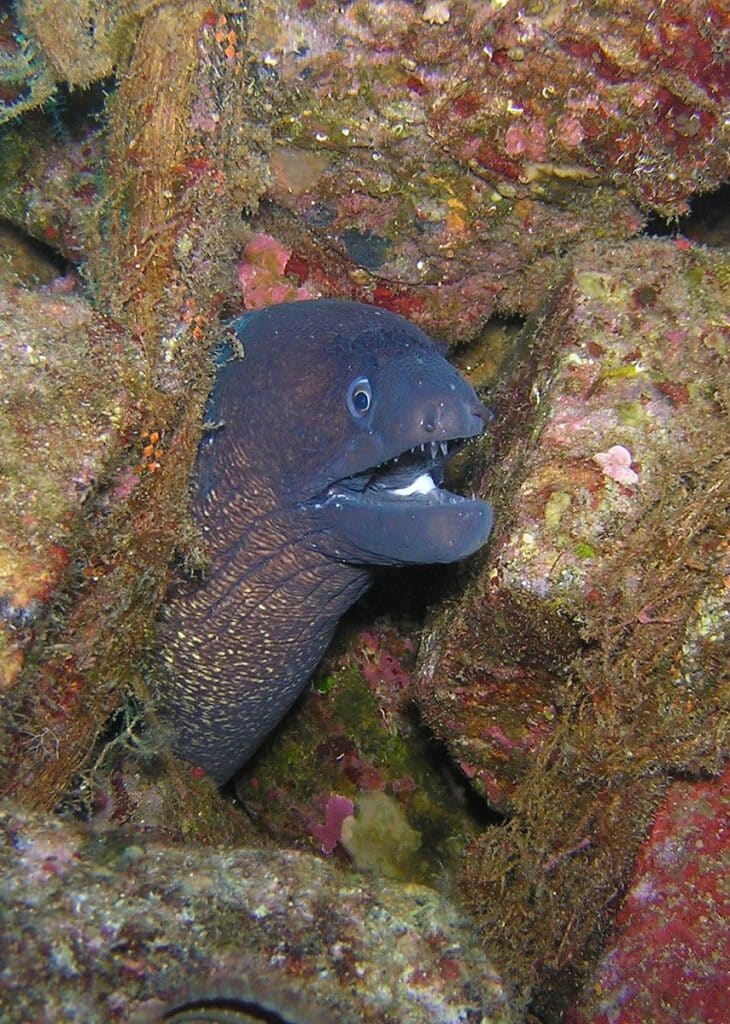
Life cycle
Species in the order Anguilliformes, the eels, are known for their rather complicated life cycles. This includes the Mediterranean moray eel. Studies have found the species spawns during springtime, releasing tens of thousands of eggs.
The eggs spend some time floating freely as part of the plankton community. After this, they hatch into Leptocephali, basically tiny transparent larvae. It takes up to two years for them to turn into anything that remotely looks like a real moray eel.
Even after they metamorphose, Mediterranean morays are slow growers. According to research, it takes them around 7 years to reach maturity! They also have long lifespans, with the oldest specimens found being around 15 years old.
Edible?
Yes, edible! Apparently their consumption goes all the way back to the Roman times. If you visit a fish market in the Mediterranean, like in Spain, there’s a chance you’ll find Mediterranean morays among the species offered for sale.
Although moray eels aren’t exactly something you’ll find on every restaurant menu, they are apparently quite tasty. Their skin needs to be de-slimed with salt or removed before cooking and they do need careful filleting, as they’re rather full of bones.
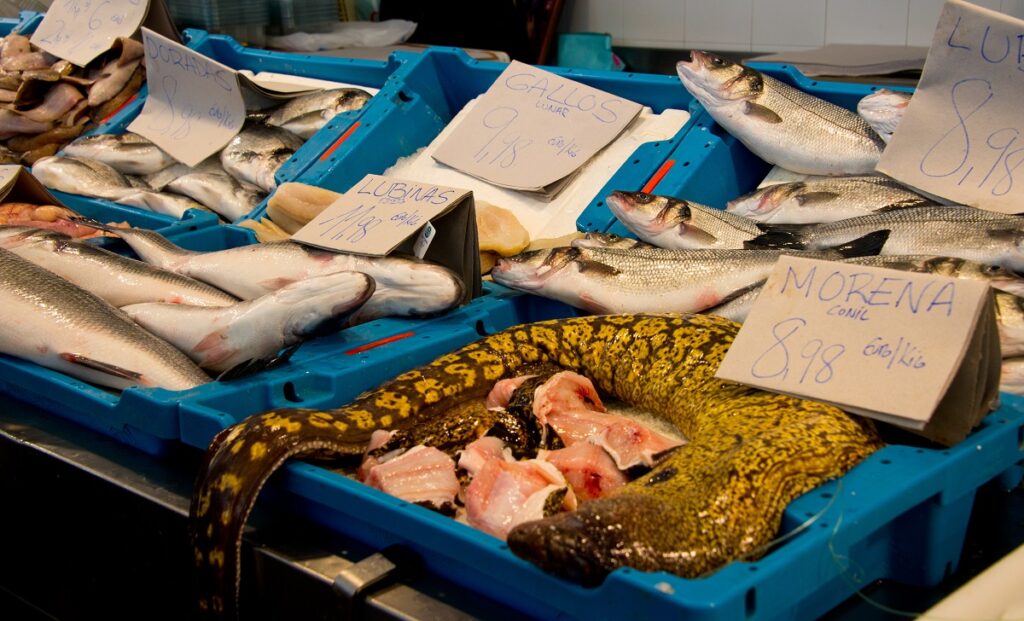
If you have any more questions about the Mediterranean moray eel or if you’ve spotted one while snorkeling and would like to share, don’t hesitate to leave a comment below!
PS: Fascinated by moray eels (like me)? I’m pleased to also introduce you to the chain moray eel, a colorful Western Atlantic species.
Sources & further reading
- Jiménez, S., Schönhuth, S., Lozano, I. J., González, J. A., Sevilla, R. G., Diez, A., & Bautista, J. M. (2007). Morphological, ecological, and molecular analyses separate Muraena augusti from Muraena helena as a valid species. Copeia, 2007(1), 101-113.
- Matić-Skoko, S., Tutman, P., Petrić, M., Skaramuca, D., Đikić, D., Lisičić, D., & ko Skaramuca, B. (2011). Mediterranean moray eel Muraena helena (Pisces: Muraenidae): biological indices for life history. Aquatic Biology, 13(3), 275-284.
- Matić-Skoko, S., Tutman, P., Bojanić Varezić, D., Skaramuca, D., Đikić, D., Lisičić, D., & Skaramuca, B. (2014). Food preferences of the Mediterranean moray eel, Muraena helena (Pisces: Muraenidae), in the southern Adriatic Sea. Marine Biology Research, 10(8), 807-815.
- Quigley, D. T. G., & Flannery, K. (2004). First record of the moray eel Muraena helena L. from Irish waters and a review of NW European records. The Irish Naturalists’ Journal, 27(11), 426-428.
- Randall, J. E., Aida, K., Oshima, Y., Hori, K., & Hashimoto, Y. (1981). Occurrence of a crinotoxin and hemagglutinin in the skin mucus of the moray eel Lycodontis nudivomer. Marine Biology, 62, 179-184.
- Tiralongo, F., Russo, F., & Colombo, M. (2019). From scuba diving to social networks: a curious association between two small fish species, Lepadogaster candolii Risso, 1810 and Parablennius rouxi (Cocco, 1833), and Muraena helena (Linnaeus, 1758) coming from citizen science. Regional Studies in Marine Science, 29, 100648.

